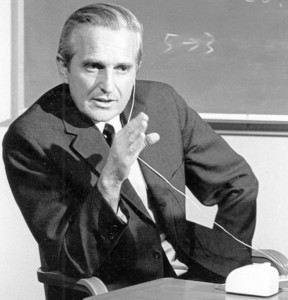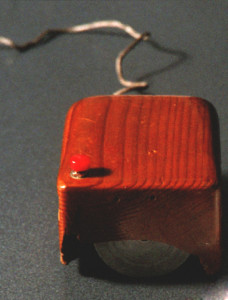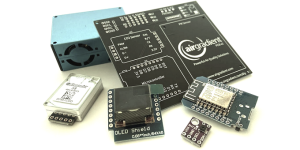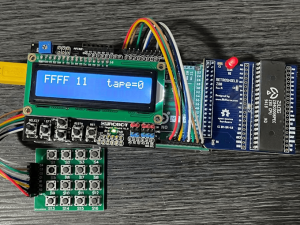In the 50s one of the biggest problems in the computer science was the lack of an easy interaction between the users and computers. In the most of the cases the only interaction with the home computer screen was by the keyboard.
Since the age of the textual OS (operating systems) ended and the age of the window OS began, the users needed a better user experience and an easy way to manage the windows on the screen. In 1963 Douglas Engelbart, a researcher and electronics engineer of the DARPA (Defense Advanced Research Project ), he applied for patenting an electronic device based on a wood cube and two perpendicular iron wheels. He got to patent the device together Bill English in 1970 and he named it MOUSE.
The first example of MOUSE, the TRACKBALL (a sphere which measured the movements and sent them to a pointer), was a project of the Canadian Navy, but the device had never been patented because the military confidentiality. The MOUSE with a TRACKBALL was instead a project of the German company Telefunken but Engelbart had already applied for patenting his device before the Telefunken’s product was exhibited to the public. The first computer which used the MOUSE was the Xerox Alto, but the first man which foresaw the MOUSE’s potentiality in an OS with User Interface was Steve Jobs with the Apple Lisa and Macintosh. In the last years of 80s Engelbart founded the Doug Engelbart institute as an office of the SRI international in the University of Stanford where he studied. In 2000s the USA president Bill Clinton gave him the National Medal of Technology, the most important acknowledgement in the USA.


















 Le estati sempre più torride portano con sé una serie di sfide per le batterie delle auto elettriche, causando potenziali malfunzionamenti, riduzioni della durata e persino danni permanenti. Questi problemi non solo peggiorano le prestazioni del veicolo, ma ne compromettono anche l'affidabilità generale. Proprio come il freddo, anche il caldo estremo rappresenta una minaccia significativa per le batterie al litio, cuore pulsante delle auto elettriche moderne. Le alte temperature possono influenzare negativamente qualsiasi dispositivo tecnologico, comprese le auto elettriche, esponendole a rischi di surriscaldamento quando vengono lasciate al sole per lunghi periodi. Questa situazione è particolarmente critica in un contesto in cui la diffusione delle vetture elettriche rappresenta una delle principali sfide e opportunità per la mobilità sostenibile. Tuttavia, il […]
Le estati sempre più torride portano con sé una serie di sfide per le batterie delle auto elettriche, causando potenziali malfunzionamenti, riduzioni della durata e persino danni permanenti. Questi problemi non solo peggiorano le prestazioni del veicolo, ma ne compromettono anche l'affidabilità generale. Proprio come il freddo, anche il caldo estremo rappresenta una minaccia significativa per le batterie al litio, cuore pulsante delle auto elettriche moderne. Le alte temperature possono influenzare negativamente qualsiasi dispositivo tecnologico, comprese le auto elettriche, esponendole a rischi di surriscaldamento quando vengono lasciate al sole per lunghi periodi. Questa situazione è particolarmente critica in un contesto in cui la diffusione delle vetture elettriche rappresenta una delle principali sfide e opportunità per la mobilità sostenibile. Tuttavia, il […] AirGradient è un'azienda che progetta e produce dispositivi per il monitoraggio della qualità dell'aria professionali, accurati e di lunga durata, open source e open hardware. Questi monitor possono essere utilizzati per il monitoraggio della qualità dell'aria sia domestica che esterna. I monitor della qualità dell'aria di AirGradient sono progettati per essere economici e personalizzabili e sono dotati di un codice completamente open source in modo che gli utenti possano apportare facilmente modifiche. La natura open hardware permette anche di costruire in completa autonomia il proprio dispositivo personalizzato. In questo articolo andremo a descrivere come realizzare una versione base di questo dispositivo. Introduzione I dispositivi di monitoraggio di AirGradient sono dotati di sensori che misurano diversi parametri della qualità dell'aria come […]
AirGradient è un'azienda che progetta e produce dispositivi per il monitoraggio della qualità dell'aria professionali, accurati e di lunga durata, open source e open hardware. Questi monitor possono essere utilizzati per il monitoraggio della qualità dell'aria sia domestica che esterna. I monitor della qualità dell'aria di AirGradient sono progettati per essere economici e personalizzabili e sono dotati di un codice completamente open source in modo che gli utenti possano apportare facilmente modifiche. La natura open hardware permette anche di costruire in completa autonomia il proprio dispositivo personalizzato. In questo articolo andremo a descrivere come realizzare una versione base di questo dispositivo. Introduzione I dispositivi di monitoraggio di AirGradient sono dotati di sensori che misurano diversi parametri della qualità dell'aria come […] Affascinato dall'idea di costruire un computer fai-da-te UT-88 degli anni '80 a 8 bit, Evgeny Adamenkov ha scelto di seguire un approccio più moderno, realizzando il suo remake con un Arduino Mega 2560, un RetroShield Z80, un display LCD 16x2 e una tastiera 4x4. Incuriosito dall'idea di costruire un computer fai-da-te UT-88 degli anni '80 a 8 bit, Evgeny Adamenkov ha optato per un approccio più moderno, realizzando il suo remake con un Arduino Mega 2560, un RetroShield Z80, un display LCD 16x2 e una tastiera 4x4. Questo progetto non solo preserva l'essenza del computer originale, ma introduce anche una maggiore facilità d'uso grazie alla programmabilità dell'Arduino. Evgeny ha eliminato la necessità di saldature complesse e componenti vintage, rendendo il […]
Affascinato dall'idea di costruire un computer fai-da-te UT-88 degli anni '80 a 8 bit, Evgeny Adamenkov ha scelto di seguire un approccio più moderno, realizzando il suo remake con un Arduino Mega 2560, un RetroShield Z80, un display LCD 16x2 e una tastiera 4x4. Incuriosito dall'idea di costruire un computer fai-da-te UT-88 degli anni '80 a 8 bit, Evgeny Adamenkov ha optato per un approccio più moderno, realizzando il suo remake con un Arduino Mega 2560, un RetroShield Z80, un display LCD 16x2 e una tastiera 4x4. Questo progetto non solo preserva l'essenza del computer originale, ma introduce anche una maggiore facilità d'uso grazie alla programmabilità dell'Arduino. Evgeny ha eliminato la necessità di saldature complesse e componenti vintage, rendendo il […] La robotica educativa rappresenta una delle più avvincenti e potenti modalità di apprendimento contemporaneo, in grado di integrare efficacemente i principi di STEM (Scienza, Tecnologia, Ingegneria e Matematica) nelle aule di tutto il mondo. In un'era dove le competenze digitali sono diventate imprescindibili, l'adozione di programmi di robotica educativa non solo arricchisce il bagaglio conoscitivo degli studenti, ma stimola anche la creatività, la capacità di problem solving e il lavoro di squadra. In questo articolo, esploriamo come la robotica educativa sta rivoluzionando l'insegnamento delle discipline STEM e delineando le sue potenzialità per il futuro dell'educazione. La robotica educativa coinvolge gli studenti in attività pratiche e interattive, permettendo loro di costruire, programmare e manipolare robot. Questo approccio hands-on favorisce un apprendimento […]
La robotica educativa rappresenta una delle più avvincenti e potenti modalità di apprendimento contemporaneo, in grado di integrare efficacemente i principi di STEM (Scienza, Tecnologia, Ingegneria e Matematica) nelle aule di tutto il mondo. In un'era dove le competenze digitali sono diventate imprescindibili, l'adozione di programmi di robotica educativa non solo arricchisce il bagaglio conoscitivo degli studenti, ma stimola anche la creatività, la capacità di problem solving e il lavoro di squadra. In questo articolo, esploriamo come la robotica educativa sta rivoluzionando l'insegnamento delle discipline STEM e delineando le sue potenzialità per il futuro dell'educazione. La robotica educativa coinvolge gli studenti in attività pratiche e interattive, permettendo loro di costruire, programmare e manipolare robot. Questo approccio hands-on favorisce un apprendimento […] Conosciamo tutti il giroscopio e la sua utilità negli smartphone? Si tratta di piccoli dispositivi che sono il vero futuro della tecnologia mobile. Questa breve guida ha lo scopo di offrire una panoramica dettagliata sull'importanza dei giroscopi negli smartphone, evidenziandone le funzionalità e gli utilizzi pratici. L'argomento è di grande interesse per gli appassionati di tecnologia e per coloro che desiderano comprendere meglio come le tecnologie avanzate migliorano la nostra vita quotidiana. I giroscopi sono strumenti tecnologici avanzati utilizzati per misurare e mantenere l'orientamento di un oggetto nello spazio. Basati sul principio della conservazione del momento angolare, i giroscopi rilevano i cambiamenti di orientamento rispetto a un asse fisso. Questi dispositivi sono costituiti da un rotore in rapida rotazione, il […]
Conosciamo tutti il giroscopio e la sua utilità negli smartphone? Si tratta di piccoli dispositivi che sono il vero futuro della tecnologia mobile. Questa breve guida ha lo scopo di offrire una panoramica dettagliata sull'importanza dei giroscopi negli smartphone, evidenziandone le funzionalità e gli utilizzi pratici. L'argomento è di grande interesse per gli appassionati di tecnologia e per coloro che desiderano comprendere meglio come le tecnologie avanzate migliorano la nostra vita quotidiana. I giroscopi sono strumenti tecnologici avanzati utilizzati per misurare e mantenere l'orientamento di un oggetto nello spazio. Basati sul principio della conservazione del momento angolare, i giroscopi rilevano i cambiamenti di orientamento rispetto a un asse fisso. Questi dispositivi sono costituiti da un rotore in rapida rotazione, il […]

